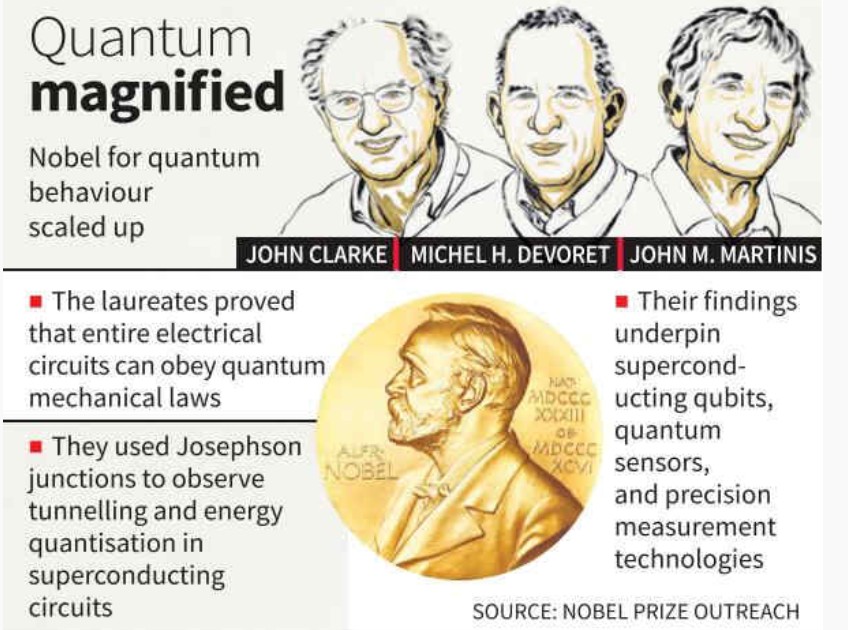Why in the News?
The 2025 Nobel Prize in Physics has been awarded to John Clarke, Michel Devoret, and John Martinis for their discovery of macroscopic quantum mechanical tunnelling and energy quantisation in an electric circuit.

Discovery of Macroscopic Quantum Effects:
- Essence of the Discovery: John Clarke, Michel Devoret, and John Martinis proved that quantum effects—tunnelling and energy quantisation—can occur in macroscopic electrical circuits, not just in atoms or particles.
- Experiments (UC Berkeley, 1984–85): Demonstrated that superconducting circuits, visible to the naked eye, act as quantum systems when isolated from external disturbances.
- Observed Phenomena:
- Macroscopic Quantum Tunnelling: Electric current “jumps” through an insulating barrier even when classical physics predicts no flow.
- Energy Quantisation: The circuit holds only discrete energy levels, behaving like an artificial atom that exchanges energy in fixed quanta.
- Scientific Breakthrough: First experimental proof that quantum mechanics governs engineered large-scale systems, forming the foundation of quantum computing.
The Josephson Junction:
- Structure: Two superconductors separated by a thin insulating layer, allowing the passage of Cooper pairs paired electrons that move as a single quantum entity.
- Mechanism: Though insulators block current in classical systems, Cooper pairs tunnel through the barrier, producing a supercurrent without resistance.
- Key Berkeley Findings:
- The phase difference across the junction behaved as a quantum variable, showing discrete energy states.
- Spontaneous tunnelling of current produced measurable voltage, confirming macroscopic quantum tunnelling.
- Outcome: The Josephson junction became the first laboratory model of macroscopic quantum behaviour and the prototype for superconducting qubits used in today’s quantum computers.
Significance:
- Redefined Quantum Boundaries: Established that quantum laws are universal, applying from electrons to circuits of billions of atoms when quantum coherence is preserved.
- Foundation for Quantum Computing: Provided the conceptual basis for superconducting qubits, now central to Google, IBM, and TIFR quantum processors.
- Technological Impact: Enabled innovations in quantum sensors, precision metrology, and quantum communication through microwave-to-optical conversion.
- Philosophical Insight: Resolved the scale question of how large a system can remain quantum, proving that superconducting isolation preserves coherence even at macroscopic levels.
- Legacy: Bridged the quantum–classical divide, converting a theoretical boundary into experimentally verified reality, launching the modern quantum technology era.
| [UPSC 2022] Which one of the following is the context in which the term “qubit” is mentioned?
Options: (a) Cloud Services b) Quantum Computing* (c) Visible Light Communication Technologies (d) Wireless Communication Technologies |
Get an IAS/IPS ranker as your 1: 1 personal mentor for UPSC 2024

